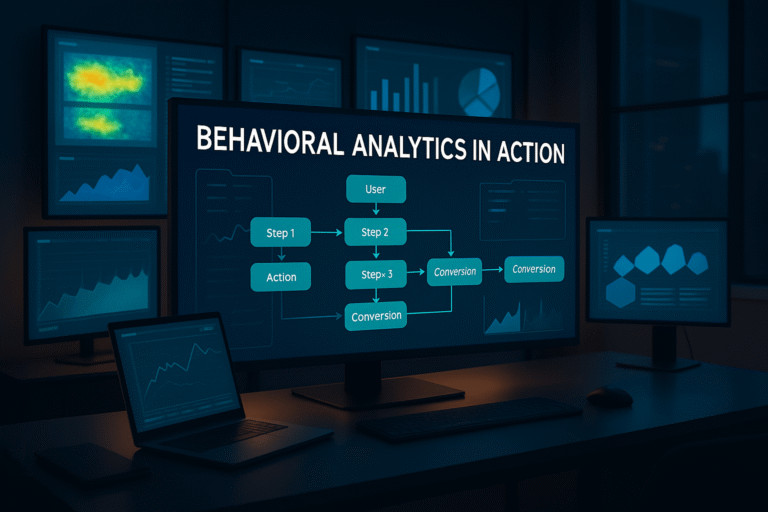Behavioral Analytics in Action: 2025 Trends to Boost Performance Marketing ROI

In the fast-moving world of performance marketing, one thing is clear—generic targeting and guesswork are fading away. Brands that thrive today are those that understand not just who their audience is, but how they behave in the moments that matter.
That’s where behavioral analytics steps in. By capturing and interpreting real-time user interactions—click patterns, session flows, scroll depth, engagement triggers—you’re no longer marketing to a vague “persona,” but to actual, living customer behavior.
And in 2025, behavioral analytics has evolved from a ‘nice-to-have’ to a core driver of ROI. It’s not just about seeing data; it’s about acting on it instantly to maximise campaign performance.
What is Behavioral Analytics in Performance Marketing?
Behavioral analytics is the practice of tracking, analysing, and interpreting user actions across digital touchpoints. It’s about going deeper than demographics—focusing on what people actually do rather than what they say they will do.
This includes:
Click paths – Which sequence of pages or ads a user navigates through.
Engagement triggers – The specific moments (like hovering over a button or replaying a video) that indicate intent.
Conversion blockers – Where and why users drop off.
Content consumption habits – What format, length, or tone works best for them.
The goal? Optimise every touchpoint so more visitors take the actions that matter—whether that’s clicking ‘Buy Now,’ filling a lead form, or watching your product video to the end.
Why Behavioral Analytics is a Game-Changer in 2025
With increasing privacy regulations, the shift to cookieless tracking, and changes in consumer expectations, traditional targeting methods are losing their precision.
Behavioral analytics doesn’t rely on intrusive personal data—it relies on observed actions. That makes it both privacy-friendly and incredibly insightful.
Here’s why it’s reshaping performance campaigns right now:
Real-Time Optimisation
You can tweak ad creatives, landing pages, and offers based on live user activity—not after the campaign is over.Personalisation at Scale
Behavioral patterns allow you to segment audiences dynamically—serving hyper-relevant ads without creepy micro-targeting.Higher Conversion Rates
By identifying micro-frictions in the journey (like slow-loading CTAs or poor mobile UX), you remove blockers before they cost you sales.Better Attribution
Instead of guessing which ad or channel worked, you can see the actual behaviors that led to a conversion.
Key 2025 Trends in Behavioral Analytics for Performance Marketing
Let’s break down the emerging trends that are helping marketers turn raw behavior data into actionable ROI.
1. Predictive Behavioral Targeting
Thanks to AI, we’re no longer just looking at what happened—we can forecast what will happen next.
Platforms now model future user behavior based on historical interactions, meaning you can anticipate drop-offs, identify high-LTV customers earlier, and trigger campaigns before intent fades.
Example in action:
An e-commerce brand sees a segment of visitors repeatedly viewing a premium product without purchasing. Predictive analytics can score these users as “high intent” and automatically push a limited-time offer ad across channels.
2. Heatmaps & Session Replays in Ad Landing Pages
Instead of just A/B testing headlines or colors, marketers are now combining heatmaps with behavioral event tracking to see exactly where attention flows.
This helps pinpoint if users are missing key CTAs, getting stuck on form fields, or scrolling past your hero offer without engaging.
Quick win:
If heatmaps show that most mobile users never reach your form because it’s buried halfway down the page, move it higher and watch conversion rates climb.
3. Multi-Device Journey Mapping
Users now bounce between smartphones, desktops, smart TVs, and even in-car displays before taking action.
Behavioral analytics tools are finally catching up, stitching these interactions together for a single customer view.
Why it matters:
If a user clicked a video ad on mobile but purchased later via desktop, you can now connect those events and correctly attribute value to your mobile ads.
4. Behavioral Segmentation for Retargeting
Retargeting in 2025 isn’t about chasing everyone who visited your site—it’s about chasing the right behaviors.
Cart abandoners who also viewed a product video = prime retargeting audience.
Visitors who bounced in under 5 seconds? Better to exclude them.
This refined targeting cuts ad waste and boosts ROAS.
5. Emotional Triggers & Interaction Analysis
The latest tools can measure engagement sentiment—tracking pauses, replays, rapid scrolls, and even facial expressions (in opt-in scenarios) to gauge emotional response to creative assets.
Why it works:
Ads that elicit emotional engagement tend to drive higher recall and conversions. If your audience lingers on a section showing customer testimonials, it’s a signal to expand that in future creatives.
How to Apply Behavioral Analytics in Your Campaigns
Here’s a practical 5-step framework to integrate behavioral analytics into your performance marketing strategy.
Step 1: Define Your Core Conversion Actions
Before tracking behaviors, identify the exact actions you want to measure—purchases, sign-ups, demo requests, content downloads.
Step 2: Implement the Right Tools
Popular behavioral analytics platforms include:
Hotjar – Heatmaps & session recordings.
Mixpanel – Event-based tracking & cohorts.
Google Analytics 4 – Enhanced event tracking and funnel reports.
FullStory – UX behavior analytics.
Choose based on your campaign scope and budget.
Step 3: Track Micro-Conversions
Don’t just measure final sales—track the small steps that lead there:
Clicking “Add to Wishlist”
Watching 75% of a video
Downloading a pricing PDF
These micro-conversions often signal future high-value actions.
Step 4: Analyse Drop-Off Points
Look for friction areas where intent is lost.
Is your checkout page losing 20% of mobile users? Is your form abandonment rate unusually high? Fixing these can lift ROI instantly.
Step 5: Build Behavior-Driven Segments
Use behavioral patterns to create smarter audience segments:
Engaged Non-Buyers – Retarget with urgency offers.
High-LTV Repeat Visitors – Upsell premium products.
Price-Sensitive Clickers – Show discount-led creatives.
Real-World Impact: Behavioral Analytics in Action
A SaaS company running PPC campaigns found that 40% of trial sign-ups came from users who first interacted with their feature comparison tool.
By identifying this pattern, they started running ads directly promoting the tool rather than the generic homepage.
Result? Trial conversions increased by 52% in just six weeks, with no extra ad spend.
Common Mistakes to Avoid
Tracking Everything Without Purpose – Too much noise hides the signal. Focus on behaviors linked to your KPIs.
Ignoring Mobile Behavior – Over half of user journeys are mobile-first; don’t base decisions solely on desktop data.
Making Changes Without Testing – Every insight should be validated through controlled experiments before full rollout.
The Future of Behavioral Analytics in Performance Marketing
By 2027, expect behavioral analytics to merge even more with real-time creative automation, where ads self-adjust based on user behavior mid-session.
We’ll also see growth in privacy-first behavioral tracking—using on-device analytics that never store personal identifiers, keeping both compliance officers and customers happy.
Final Thoughts
In 2025, behavioral analytics is no longer a “bonus” metric for marketers—it’s the engine that drives higher ROI.
It shifts the focus from static demographics to living, breathing customer actions. And in a competitive ad landscape, those who understand user behavior best will win the conversion game.
If you haven’t already, now is the time to map, measure, and master your audience’s behavioral patterns—because in performance marketing, actions speak louder than clicks.
